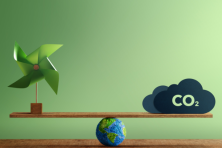Washington made history in 2021, becoming just the second state in the country to implement a cap-and-invest program, the Climate Commitment Act (CCA), which officially became state law on January 1st. The CCA will drastically cut emissions and toxic air pollution from Washington’s biggest polluters throughout the state, while also generating billions of dollars to invest in clean energy, our communities, and environmental justice.
But how will this ambitious law translate to real, tangible change for communities, the environment, and our health? This three-part blog series highlights the promise of the Climate Commitment Act, and how, if we invest revenue from this program strategically, we can accelerate our transition to a clean energy future while cutting climate pollution and closing the gap on historic health disparities in overburdened communities.
Cap-and-Invest 101
In order to understand how a cap-and-invest program will bring clean energy, clean air, and direct investments in Washington’s communities, it’s helpful to take a closer look at the basics of the program. As its name would suggest, cap-and-invest works by setting a cap on climate pollution that gradually shrinks between now and 2050, when emissions must reach 95% below 1990 levels – one of the nation’s most ambitious emissions reduction targets. The graph below shows how this cap will get us to our 2050 deadline.
Who actually has to reduce emissions under the law?
Washington’s biggest polluters – energy plants, energy suppliers, industrial facilities, and other entities that are responsible for more than 25,000 metric tons of carbon pollution annually – will purchase an allowance through a state-run bidding process at quarterly auctions for every one metric ton of carbon dioxide equivalent they emit.The fewer emissions each entity emits, the fewer allowances it will need to purchase and vice versa.
When do the auctions start?
On February 28th, Ecology will hold its first allowance auction. This is where the “invest” portion of the law comes in. The revenue generated through this auction process is anticipated to reach about $1 billion per year and must be invested in climate and clean energy projects for Washington communities. The law mandates that a minimum of 35% (and a stated goal of 40%) of investments must directly benefit overburdened communities. This is one provision of many aimed at an intentional effort to reduce the disproportionate impacts of climate change and poor air quality on low-income, Black, and Indigenous communities, as well as other communities of color, and to ensure equitable distribution of the benefits of our new climate investments. We’ll dig into this provision and other ways the bill aims to center equity and justice in its implementation in Part 2 and 3 of this series.
Is industry exempt?
Emissions-Intensive Trade-Exposed Industries are covered under the cap and not exempt from complying with the law. Manufacturers, refineries, and other industries that have a large carbon footprint but compete in national markets are categorized as Emissions-Intensive, Trade-Exposed (EITEs) entities in the CCA. EITEs will be given free allowances to account for the potential for carbon emissions “leakage.” Leakage refers to when businesses, faced with high costs or technological challenges with reducing their emissions, choose to relocate to areas with weaker environmental protections, rather than reducing their emissions, which can result in a net increase in global emissions. EITEs will receive their allowances for free, but their emissions are still counted under the cap. In other words, EITEs are not exempt from the emission-reduction requirements of the program. EITEs’ ability to sell these no-cost allowances also acts as an incentive to reduce emissions and makes it more cost-effective to pursue investments in clean energy in industries that face a longer road to decarbonizing.
It is worth noting that maritime and aviation sectors are currently not part of the program because these sectors are federally regulated. However, it is still critical to reduce emissions from these sectors, and there are creative options state lawmakers can pursue to push them towards using cleaner fuels.
What about utilities?
Washington’s investor-owned utilities also receive free allowances through the program to help mitigate cost impacts on low-income customers who already experience a high energy burden. In fact, the CCA requires gas utilities to sell an increasing share of their no-cost allowances and put that money directly towards eliminating any excess cost burden on low-income customers. While electric utilities aren’t required to sell their free allowances to assist with compliance costs, they can choose to sell this excess and are required to reinvest the revenue for the benefit of their customers.
A Preview of What’s to Come
The CCA is just one component of a much larger, and broader-reaching climate law. Our next blog will spotlight the CCA’s critical safeguards that will ensure environmental justice and equity remain at the forefront of implementation, including close review by the Environmental Justice Council, tribal consultation, and investments in overburdened communities. This blog will also highlight some of the key lessons learned from California’s cap-and-invest policy – an impetus for the CCA’s creation of a new air quality and health disparities program to ensure the law reduces not just global emissions, but also local air pollution.







